Include lighting in some rooms or on the street for the whole dark period is unreasonable. To burn light only when you need, a movement sensor is put in the power supply chain. In the "normal" state, it breaks the power supply. When a non-moving subject in its zone appears, the contacts are closed, the lighting turns on. After the object disappears from the action zone, the light turns off. Such an algorithm of work performed perfectly in street lighting, in the illumination of the utility rooms, corridors, basements, entrances and stairs. In general, in those places where people appear only periodically. So for savings and convenience, it is better to put a motion sensor to turn on light.
Types and varieties
Motion sensors for switching on light can be different types, are intended for different operating conditions. First of all, it is necessary to watch where the device can be installed.
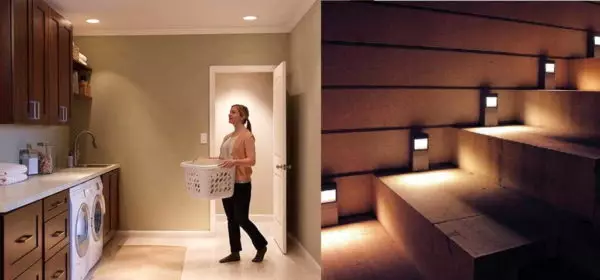
Motion sensor for switching on light is needed not only on the street
Street motion sensors have a high degree of body protection. For normal operation in the open air, the sensors with IP are not lower than 55, but better - above. To install in the house, you can take IP 22 and higher.
Power type
Next, it is necessary to take into account, from which source the light sensor is powered. There are the following options:
- Wired power sensors from 220 V.
- Wireless, powered by batteries or batteries.
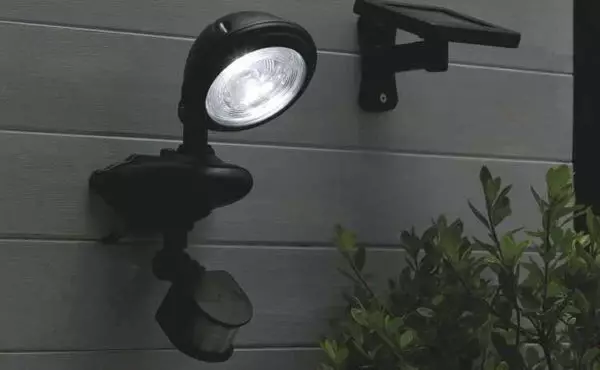
Motion sensors are wired and wireless
The most numerous group is wired to connect to 220 V. Wireless less, but they are also sufficient. They are good if you need to include lighting, operating from low-voltage current sources - battery or solar panels, for example.
The method of determining the presence of movement
Motion sensor To turn on light can determine moving objects using various detection principle:
- Infrared motion sensors. React to heat released by the body of warm-blooded creatures. Belong to passive devices, as it does not produce anything, only registers radiation. These sensors react to the movement of animals, including, so that there may be false responses.
- Acoustic motion sensors (noise). Also belong to the passive group of equipment. They react to noise, can be included from cotton, sound opened door. They can be used in the basements of private houses, where the noise occurs only there anyone comes. In other places, use is limited.
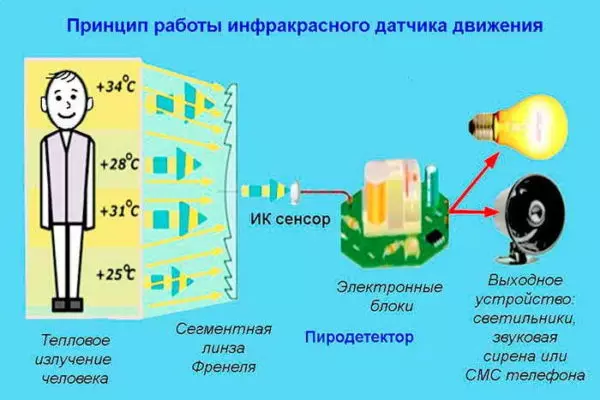
The work of infrared motion sensors is based on the heat tracking, highlighted by a person.
- Microwave motion sensors. Reference to the group of active devices. They themselves produce waves in the microwave range and track their return. In the presence of a moving object, the contacts are closed / unfolds (there is a different type). There are sensitive models that "see" even through partitions or walls. Usually used in security systems.
- Ultrasound. The principle of action is the same as the microwave, differs the range of emitted waves. This type of devices are rarely used, since animals can react to ultrasound, and a long-term impact on a person (the devices constantly generate radiation) will not bring use.
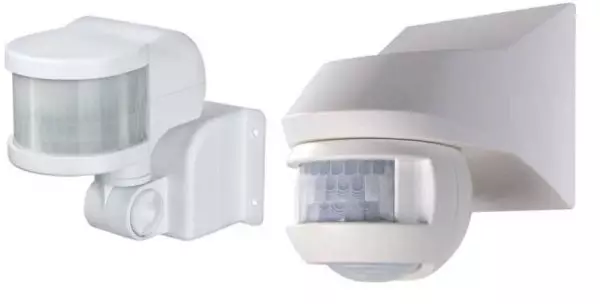
Miscellaneous execution, but color, mostly white and black
- Combined (dual). Combine several ways to detect movement. They are more reliable, have less false positives, but also more expensive.
Most often, infrared motion sensors are used to turn on the street or at home. They have a low price, a large radius of action, a large number of adjustments that will help you configure it. On the stairs and in long corridors it is better to put a sensor with an ultrasound or microwave. They are able to enable lighting even if you are still far from the light source. In the security systems, they are recommended for the installation of microwaves - they detect the movement even behind the partitions.
Specifications
After it was decided what kind of motion sensor to turn on the light you will put, you need to choose its specifications.

In the technical characteristics of wireless models there are more frequencies on which they operate and the type of batteries
Corner view
The motion sensor for switching on light can have a different viewing angle in the horizontal plane - from 90 ° to 360 °. If the object can be approached from any direction, they put sensors with a radius of 180-360 ° - depending on its location. If the device is fixed on the wall, 150 ° is sufficient if 360 ° is already on the column. In rooms you can use those that track movement in the narrow sector.
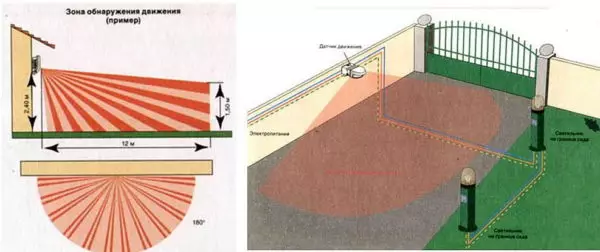
Depending on the installation site and the required detection zone, the review radius is chosen
If the door is one (the utility room, for example), there may be a sufficiently narrow-band sensor. If you enter the room from two or three sides, the model should be able to see at least 180 °, and better - in all directions. The wider "coverage", the better, but the cost of wide-angle models is significantly higher, so it is worth proceeding from the principle of reasonable sufficiency.
There is also an angle of view vertically. In ordinary inexpensive models, it is 15-20 °, but there are models that can cover up to 180 °. Wide-angle motion detectors are usually put in security systems, and not in lighting systems, since their value is solid. In this regard, it is worth choosing the height of the installation of the device correctly: to "dead zone" in which the detector simply does not see anything, was not in the place where the movement is most intense.
Range
Here again, it is worth choosing, taking into account that the motion sensor will be installed in the room to turn on light or on the street. For the premises of the radius of action of 5-7 meters, it is enough with your head.
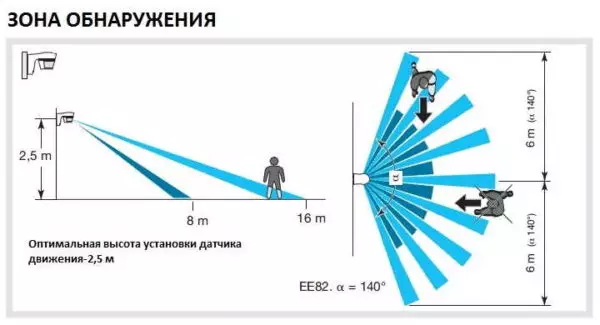
Call a range with a reserve
For the street, the installation of more "long-range" is desirable. But here too, see: with a large radius of coverage, false responses can be very frequent. So too much coverage area can even be a disadvantage.
Power of connected lamps
Each motion sensor to turn on the light is designed to connect a certain load - it can pass through itself a current of a certain nominal. Therefore, when choosing, you need to know, the total power of the lamps that the device will connect.
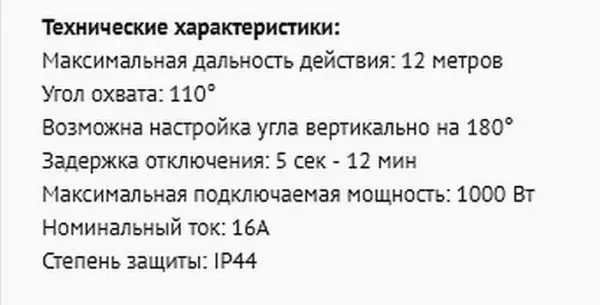
The power of the plug-in luminaires is critical if there is a group of lamps or one powerful
In order not to overpay for the increased throughput of the motion sensor, and also save on electricity accounts, use non-incandescent bulbs, and more economical - gas-discharge, luminescent or LED.
Method and installation site
In addition to explicit division on the street and "home" there is another type of division at the place of installation of motion sensors:
- Cabinet models. A small box that can be mounted on the bracket. The bracket can be fixed:
- on the ceiling;
- on the wall.
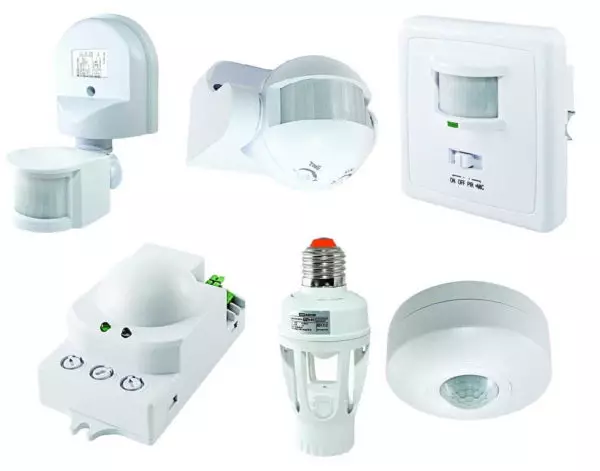
The view of the movement sensor in appearance will not determine, you can only understand the ceiling it is installed or on the wall
- Built-in models for hidden installation. Miniature models that can be installed in special recesses at an invisible place.
If the lighting is turned on only to improve comfort, choose body models, as they are cheaper with equal characteristics. Embedded put in security systems. They are miniature, but more expensive.
Additional functions
Some motion detectors have additional features. Some of them are explicit excess, others, in certain situations, can be useful.
- Built-in light sensor. If the motion sensor for switching on the light is installed on the street or indoors with the window, turn on the light in the daytime there is no need - the illumination is sufficient. In this case, either in the chain is embedded by photoorele, or the motion detector with the built-in photoelele (in one case) is used.
- Animal protection. Useful feature, if there are cats, dogs. With such a function of false positives is much less. If a big dog, even this option will not save. But with cats and small dogs, she works well.

For many useful features there will be protection against triggering when animals appear
- Delay of light disconnection. There are devices that turn off the light immediately after the object leaves the action zone. In most cases, it is inconvenient: the light is still needed. Therefore, there are convenient models with a delay, and even more convenient to those that allow this delay to regulate.
These are all functions that can be useful. Especially pay attention to animal protection and disconnect delay. These are really useful options.
Where to post
Install the motion sensor to turn on the lighting must be properly - to work correctly, stick to certain rules:
- Nearby should not be lighting devices. Light interferes with correct operation.
- Nearby should not be heating devices or air conditioners. Detectors of movement of any type react to air flows.

With an increase in the installation height, the detection zone increases, but the sensitivity is reduced.
- There should be no big objects. They flashes extensive zones.
In large rooms, the device is better installed on the ceiling. Its viewing radius must be 360 °. If the sensor should include the lighting from any movement in the room, it is installed in the center, if only some part is monitored, the distance is selected so that the "dead zone" is minimal.
Motion Sensor for Light In: Installation Schemes
In the simplest case, the motion sensor is connected to the gap of the phase wire that goes to the lamp. If we are talking about a dark room without windows, such a scheme is operational and optimal.
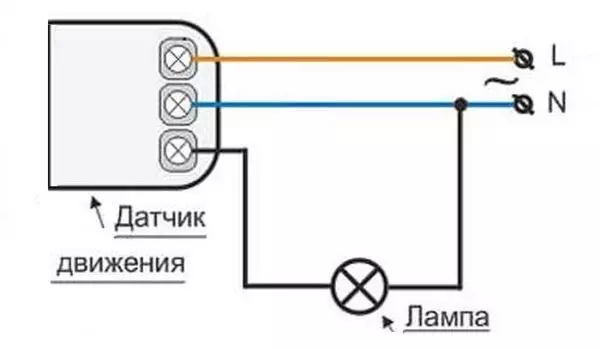
Motion sensor inclusion scheme to turn on light in the dark room
If we speak specifically about connecting the wires, then the phase and zero are triggered to enter the motion sensor (usually signed L for phase and N for neutral). From the output of the phase sensor, it is fed to the lamp, and take zero and earth to it from the shield or with the nearest junction box.
If we are talking about street lighting or turning on the light in a room with windows, you will need to or put a light sensor (photowork), or installed the switch on the line. Both devices prevent lighting in the daytime. Just one (photoelele) works in automatic mode, and the second is turned on forcibly man.
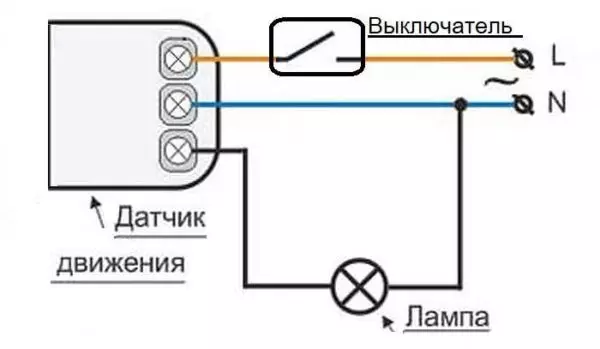
Connecting the motion sensor on the street or indoors with windows. On the site of the switch can be photoorele
They are also put in the gap of the phase wire. Only when using the light sensor, it must be set before the motion relay. In this case, it will be powered only after hemnemes and will not work "frightened" during the day. Since any electrical appliance is designed for a certain number of triggered, it will extend the life of the motion sensor.
All schemes described above have one drawback: the lighting cannot be included for a long time. If you need to spend some work on the stairs in the evening, you will have to move all the time, otherwise periodically the light will turn off.
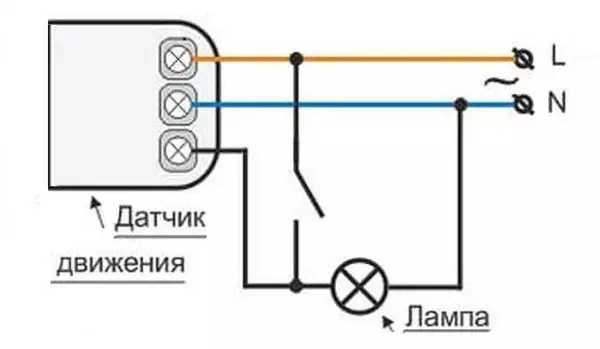
Connection diagram of the motion sensor with the possibility of long-term lighting on the sensor)
For the possibility of long-term lighting on, a switch is installed in parallel with the detector. While it is turned off, the sensor in operation, the light turns on when it works. If you need to turn on the lamp for a long period, click the switch. The lamp burns all the time until the switch is again translated into the "Off" position.
Adjustment (setting)
After mounting, the motion sensor to turn on the light must be configured. To configure almost all parameters on the case there are small rotary regulators. They can be rotated by inserting a snag into the slot, but it is better to use a small screwdriver. We describe the adjustment of the DD type motion sensor with a built-in light sensor, as they are most often put in private houses to automate street lighting.Tilt angle
For those sensors that are attached on the walls, you must first set the angle of inclination. They are fixed on the rotary brackets, with which their position changes. It must be chosen so that the controlled region is the biggest. The exact recommendations will not be possible to give, as it depends on the angle of the vertical view of the model and on what height you hung it.
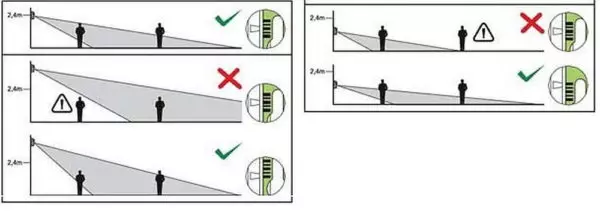
Adjustment of the motion sensor begins with an inclination angle selection
The optimal height of the motion sensor installation is about 2.4 meters. In this case, even those models that can cover only 15-20 ° vertically control sufficient space. Setting the angle of inclination is a very approximate name of what you have to do. Let's gradually change the angle of inclination, check how the sensor from different possible entry points is triggered in this position. Notes, but Mouorne.
Sensitivity
On the case, this adjustment is signed by SEN (from English Sensitive - sensitivity). The position can be changed from the minimum (min / low) to the maximum (MAX / HIGHT).
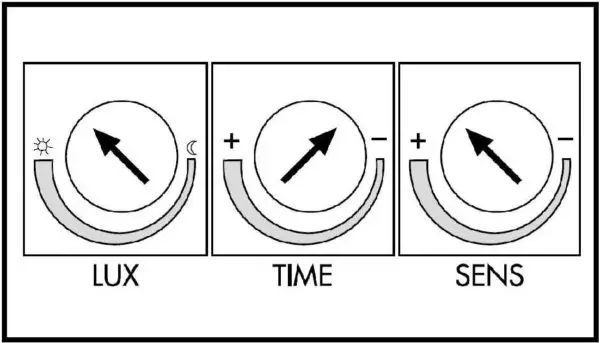
Basically, adjustments look like
This is one of the most complex settings, since it depends on it whether the sensor will be operated on small animals (cats and dogs). If the dog is big, avoid false positives will not succeed. With medium and small animals it is quite possible. The order of configuration is such: expose to a minimum, check, as it works for you and in the inhabitants of smaller growth. If necessary, the sensitivity is gradually increasing.
Delay time
Different models have a shutdown delay range different - from 3 seconds to 15 minutes. It is necessary to insert it all the same - by turning the adjusting wheel. Signally signed Time (translated from the English "time").
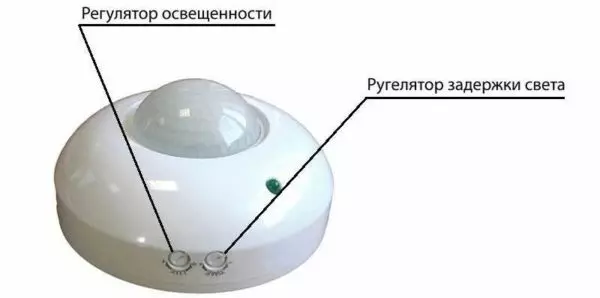
Glow time or delay time - choose how you like more
Here everything is relatively easy - knowing the minimum and maximum of your model, about choosing the position. After turning on the flashlight, freeze and check the time after which it will turn off. Next, change the position of the regulator in the desired side.
Light level
This adjustment refers to the photoyele, which we agreed, built into our motion sensor to turn on light. If there is no built-in photogele, it will simply be not. This adjustment is signed by LUX, the extreme positions are signed by Min and Max.
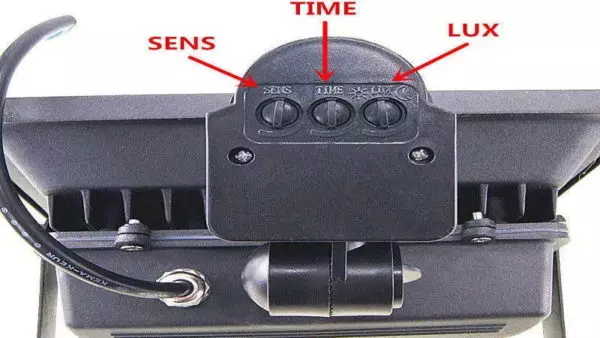
They can be on the facial or back side of the case
When connected, the regulator is set to the maximum position. In the evening, at the level of the light level, when you think the light should already turn on, turn the regulator slowly to the MIN position to the cazus, while the lamp / lamp is activated.
Now we can assume that the motion relay is configured.
Article on the topic: Gardin and Laptop Curtains - How to Apply in the Interior
